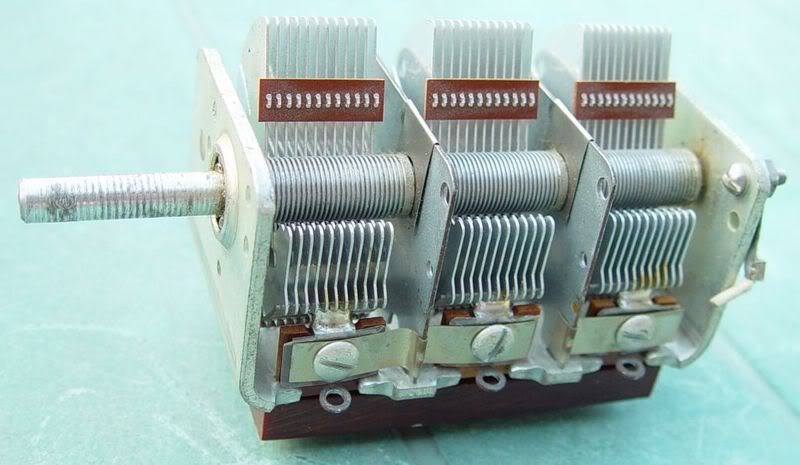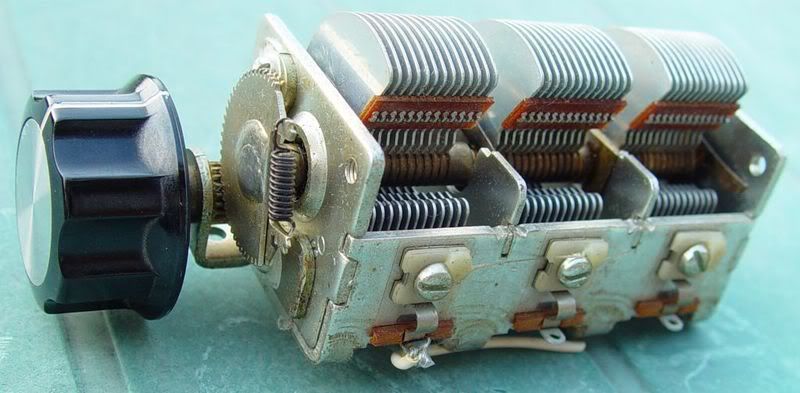|
|
Post by ChrisK on Jun 17, 2007 8:42:13 GMT -5
!UNDER CONSTRUCTION!
The purpose of this thread will be to share my designs for simple test/component substitution equipment.
This is intended to be for a capacitor substitution box, resistor substitution pots, and etc.
All will assume the possession of a digital multi-meter. If you don't have one AND know/learn how to use it, you're driving around with your eyes closed and are in danger of "an accident" and should really "just stay indoors".
One of the best test tools that one can build for guitar wiring is a capacitor substitution box. I have caps from 0.001 uF (1nF) up to 1.0 uF in common intra-decade intervals of 1, 2.2 3.3 4.7 5.6 6.8 7.5 8.5 in 1% tolerance. Along with multi-position rotary switches or banks of toggle switches, one can easily build these. One can, of course, buy them, but folks seem to want a lot of money for them.
My preferred connection method for these are banana plug/clip leads.
?Do I really need to draw a schematic for this one?
When I was in college in the mid 70's, I wrote many, many letters to companies for the school on school letterhead stating that we were "poor college students and do you have any "free stuff" that you can send? My "cut" was half of what I could them to send. We got over a dozen cubic yards of "stuff".[Hint]
I also have two 100 pF to 1,350 pF air variable caps (well, each is a three-section 365'ish pF one from really old AM radios). Using my LCR meter, I marked a scale for each one and can easily just "dial in" the right value to be replaced with a fixed value later.
(These are now about $50 to $150 IF you can find them. I guess that we save "junk" for a reason). [Hint]
|
|
|
|
Post by UnklMickey on Jun 17, 2007 21:35:42 GMT -5
One of the best test tools that one can build for guitar wiring is a capacitor substitution box. I have caps from 0.001 uF (1nF) up to 1.0 uF in common intra-decade intervals of 1, 2.2 3.3 4.7 5.6 6.8 7.5 8.7 in 1% tolerance. Along with multi-position rotary switches or banks of toggle switches, one can easily build these. One can, of course, buy them, but folks seem to want a lot of money for them.
My preferred connection method for these are banana plug/clip leads.
?Do I really need to draw a schematic for this one? Actually Chris, I've seen some that I thought were more interesting. One variation uses 4 spst mini-toggle per decade. The three switches would have, as an example 1, 2, 4, - 1nF capacitors on them, respectively. The last one had a 3.3 in parallel with a 4.7 (for a value of 8nF) This means that you would have 15 nF if all the switches in the lowest decade were turned on. A bit confusing, but not fatal. The variation with more finesse, used BCD "thumbwheel" switches for each decade. kinda slick, because the switches are marked with 0~9 that show through the window. I have seen similar switches, that have two buttons. One to increment, the other to decrement the count. They also have the numbers on them. They nest together, with end-pieces on each end, an fit through a rectangular panel opening. You slide the assembled array through the panel, from front to back, and they automatically lock in place. IIRC they were made by Omron. These are probably a bit more expensive than rotary switches and pointer knobs, but they are very compact and just look so "pro". (These are now about $50 to $150 IF you can find them. I guess that we save "junk" for a reason). [Hint] This reminds me of one big regret I have. I had the opportunity to buy 100 each Reticon SAD512 and SAD1024 bucket brigade ICs when they were being discontinued. They would have cost me $0.50 and $1.00 per unit, respectively. I just couldn't justify tying up $150 on that. I was tempted, but "wisely" chose to pass on the deal. I kick myself every time I see them advertised on e-bay for $20 or more.  |
|
|
|
Post by ChrisK on Jun 17, 2007 22:45:55 GMT -5
Yeah, I've used these in resistance decade boxes. Unless one has a bunch of caps, they get tough to make since most caps have +/- 20% tolerances and values not spaced conducive for this (cap value spacing is ratio-metric). AND, have you ever tried to explain binary numbering to most humans? Yep! These are currently $10 to $15 per switch. I bought 50 of a gold plated 1:10 pole version (not BCD or binary) for a pickup test fixture some years ago. I got them for $1.25 each surplus. They seemed like a good idea, but were a pain in the buttocks to use rapidly (push, push, push, push, push, push, push, push). Of course I had 24 of them in the fixture. If we use a RodeoShack SP12T rotary switch, counting backwards we could have (note that these values have an increment ratio of about 1.5): 0.1, 0.068, 0.047, 0.033, 0.022, 0.015 (der Voman toneski), 0.010, 0.0068, 0.0047, 0.0033, 0.0022, 0.0015. spec.e-switch.com/G-T/G510240F.pdfUsing a three section air variable for anything under 1,400 pF covers most everything else of interest (cable load simulation, treble boost on volume, pickup resonance down-tuning, etc).   |
|
|
|
Post by UnklMickey on Jun 28, 2007 1:57:12 GMT -5
AND, have you ever tried to explain binary numbering to most humans? There are 10 types of people in this world.... ...Those who understand binary, and those who do not. |
|
hugh
Meter Reader 1st Class
  
Posts: 50
Likes: 0
|
Post by hugh on Jul 8, 2007 13:11:52 GMT -5
AND, have you ever tried to explain binary numbering to most humans? There are 10 types of people in this world.... ...Those who understand binary, and those who do not. I saw this T-shirt the other day, and it made me stop and think for a minute... then I laughed. I was happy I still got it. ;D I've got a few of these variable caps laying around from old tube radios. I haven't even considered using them for anything. Now you got me thinking. |
|
|
|
Post by ChrisK on Jul 8, 2007 22:38:28 GMT -5
The old air-gap variable caps are neat (especially if you have a three section ganged one) for "dialing in" a value of parallel capacitance around 500 pF to1 nF or so to warm up a bright pickup. (Or, you can use a 25 foot coil cord [that other tone control].)
You do need an LCR meter or at lease a digital meter than can read said range of capacitance (how else will you know what you dialed).
They're also great for dialing in a volume treble bypass cap value.
|
|
|
|
Post by gumbo on Jul 15, 2007 8:17:05 GMT -5
Thank you VERY much for the air-gap heads up...sometimes it helps to go back a couple-or-three decades in brain cells..
My dear old Dad was a radio engineer and I grew up with mountains of this stuff around me as a young kid...unfortunately he passed away when I was 11, and there was so much I could still have learned from him.....
|
|